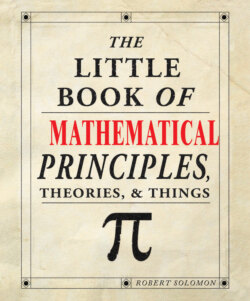Читать книгу The Little Book of Mathematical Principles, Theories & Things - Robert Solomon - Страница 32
На сайте Литреса книга снята с продажи.
3rd century BC Greece The Sand Reckoner Archimedes (287–212 BC)
ОглавлениеArchimedes asked the question:
How many grains of sand would fill the universe?
_______________
To answer this, Archimedes had to invent a way of writing numbers much larger than any used before.
At the time, the universe was thought to be finite in radius, being bounded by the sphere of the stars. In the “Sand Reckoner,” Archimedes made estimates for both the size of the universe and of a grain of sand, and had to find how many of the latter would fit into the former.
The problem was that at the time no notation existed to express such a huge number. The largest number word the Greeks had was “the myriad,” which means 10,000. They also used “the myriad myriad,” in other words, 10,000 x 10,000, or a hundred million, or 108 in modern notation.
In ordinary notation, we go up in steps of 10, then 100, then 1,000, and so on. Single-digit numbers are less than 10, two-digit numbers are less than 100, and three-digit numbers are less than 1,000. Archimedes extended this principle, replacing 10 by 108. He called all numbers up to 108 numbers of the first order. Using 108 as a starting point, he took successive multiples of this new unit. He called all numbers between 108 and 108 x 108 = 1016 numbers of the second order. This is continued to numbers of the third order and so on, ending with numbers of the myriad myriadth order, which starts at .
Now Archimedes had his number system and he concluded that the number of grains required is 10,000,000 units of the eighth order, which is 1063.
This anticipates much of modern ways of writing large numbers. It also includes a tantalizing reference to the claim of another Greek scientist, Aristarchus, that the Earth travels round the Sun.
